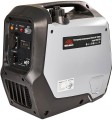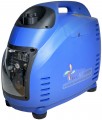Rated power
The rated power of the generator is the highest power supply that the unit is capable of delivering without problems for an unlimited time. In the “weakest” models this figure is
less than 1 kW, in the most powerful –
50 – 100 kW or even
more ; and generators with welding capabilities (see below) typically have power ratings ranging from
1 – 2 kW to
8 – 10 kW.
The main rule of choice in this case is this: the rated power must not be lower than the total power consumption of the entire connected load. Otherwise, the generator simply will not be able to produce a sufficient amount of energy, or it will work with overloads. However, to determine the minimum required generator power, it is not enough to simply add up the number of watts indicated in the characteristics of each connected device - the calculation method is somewhat more complicated. Firstly, you need to take into account that only the active power of various equipment is usually indicated in watts; In addition, many AC electrical appliances consume reactive power (the "waste" power consumed by coils and capacitors when operating at that power). And the actual load on the generator depends precisely on the total power (active plus reactive), indicated in volt-amperes. There are special coefficients and formulas for its calculation.
...The second nuance is related to the power supply of devices in which the starting power (and, accordingly, the power consumption at the moment of switching on) is significantly higher than the rated one - these are mainly devices with electric motors such as vacuum cleaners, refrigerators, air conditioners, power tools, etc. You can determine the starting power by multiplying the standard power by the so-called starting coefficient. For one type of equipment it is more or less the same - for example, 1.2 - 1.3 for most power tools, 2 for a microwave, 3.5 for an air conditioner, etc.; More detailed data is available in special sources. Starting characteristics of the load are necessary, first of all, to assess the required maximum power of the generator (see below) - however, this power is not always given in the characteristics; often the manufacturer indicates only the rated power of the unit. In such cases, when calculating for equipment with a starting coefficient of more than 1, it is worth using the starting power, and not the rated power.
Also note that if there are several outlets, the specific division of the total power among them may be different. This point should be clarified separately - in particular, for specific types of sockets (for more details, see “230 V sockets”, “400 V sockets”).Max. power
The maximum power supply that the generator can provide.
This power is slightly higher than the rated power (see above), but the maximum performance mode can only be maintained for a very short time - otherwise overload occurs. Therefore, the practical meaning of this characteristic is mainly to describe the efficiency of the generator when operating with increased starting currents.
Let us remind you that some types of electrical appliances at the moment of startup consume many times more power (and, accordingly, power) than in normal mode; this is typical mainly for devices with electric motors, such as power tools, refrigerators, etc. However, increased power for such equipment is needed only for a short time; normal operation is restored in just a few seconds. And you can evaluate the starting characteristics by multiplying the rated power by the so-called starting coefficient. For one type of equipment it is more or less the same (1.2 - 1.3 for most power tools, 2 for a microwave, 3.5 for an air conditioner, etc.); More detailed data is available in special sources.
Ideally, the maximum power of the generator should be no lower than the total peak power of the connected load - that is, the starting power of equipment with a starting factor above 1 plus the rated power of all other equipment. This will minimize the likelihood of overloads.
Engine size
The working volume of the engine in a gasoline or diesel generator (see "Fuel"). Theoretically, more volume usually means more power, but in fact, everything is not so clear. Firstly, the specific power strongly depends on the type of fuel, and in gasoline units, also on the type of internal combustion engine (see above). Secondly, similar engines of the same power can have different volumes, and there is a practical point here: with the same power, a larger engine consumes more fuel, but by itself it can cost less.
Power
The operating power of the engine installed in the generator. Traditionally stated in horsepower; 1 HP approximately equal to 735 watts.
First of all, the rated power of the generator directly depends on this indicator (see above): in principle, it cannot be higher than the engine power, moreover, part of the engine power is spent on heat, friction and other losses. And the smaller the difference between these capacities, the higher the efficiency of the generator and the more economical it is. However high efficiency affects the cost, but this difference can pay off with regular use due to fuel savings.
Fuel consumption
Specific fuel consumption in grams consumed by the generator to generate 1 kW of electricity for 1 hour. Knowing this indicator, it is possible to calculate the approximate fuel consumption in liters, taking into account the power of the connected load and the expected duration of the unit. To do this, you need to multiply the specific consumption in g / kWh by the power of the generator engine and divide the result by the density of the fuel used (approximately 830-860 kg / m³ for diesel and 710-760 kg / m³ for gasoline).
Fuel tank volume
The volume of the fuel tank installed in the generator.
Knowing the fuel consumption (see above) and the capacity of the tank, you can calculate the operating time on one gas station (if it is not indicated in the specifications). However, a more capacious tank is also more bulky. Therefore, manufacturers choose tanks based on the general level and "voracity" of the generator — in order to provide an acceptable operating time without a significant increase in size and weight. So in general, this parameter is more of a reference than practically significant.
As for the numbers, in low-power models, tanks are installed for
5 – 10 liters, or even
less ; in heavy professional equipment, this figure can
exceed 50 liters.
Fuel level indicator
A pointer that allows you to monitor the remaining fuel in the generator tank. The simplest such
indicators work only with a critical decrease in the level of fuel, warning of the need for refueling; more advanced ones constantly display the remainder. However, anyway, this feature makes it easier to keep track of the fuel supply and reduces the risk of a generator shutdown due to a forgotten refueling.
Continuous operation time
The time during which the generator is guaranteed to operate without interruption.
This parameter is indicated exclusively for liquid fuel models with a built-in tank, and according to the simplest formula: tank capacity divided by fuel consumption. However, in some models, data may be provided for a certain load level (which is specified in the notes); at a higher or lower load, the operating time will be shorter or longer, respectively. As for specific numbers, in most modern generators the operating time is
up to 8 hours - this is quite enough for backup power and occasional use. More reputable models are capable of working for
8 – 12 hours, and an indicator of
13 hours and above is typical mainly for professional solutions.
We also note that, theoretically, many generators can be refueled without shutting down, but in practice it is better to take breaks and not exceed the stated time of continuous operation - this will avoid overheating and increased wear.
USB charging port
The generator has
a USB connector(one or more) for charging various devices. Most modern smartphones and tablets can be charged from USB, and this charging method is also found in many other equipment - from cameras and flashlights to electric screwdrivers and radio-controlled models. The standard supply voltage through this connector is 5 V, but the power may be different, it should be specified separately.

